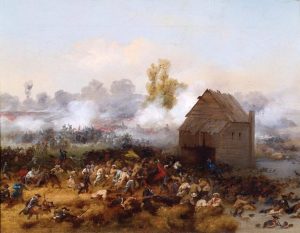“British Admiral Howe’s got troops on the water
Thirty-two thousand troops in New York harbor”
— “Right Hand Man,” Hamilton
With 400 British ships carrying 32,000 soldiers under General William Howe massing off Staten Island by July 1776, Brooklyn was ordered to be burned. Troops under General George Washington rode from Gravesend to the Jamaica Road, ordering farmers to gather all their summer grain crops away from their homes and set fire to them.
 Johannes Ditmars, an ardent patriot whose property Brooklyn College’s campus now encompasses, refused—so the soldiers did it for him. Ditmars rushed inside his barn, mounted a haystack, and shouted, “You burn this barn, you burn me!” The soldiers decided to douse the fire and leave Ditmars alone.
Johannes Ditmars, an ardent patriot whose property Brooklyn College’s campus now encompasses, refused—so the soldiers did it for him. Ditmars rushed inside his barn, mounted a haystack, and shouted, “You burn this barn, you burn me!” The soldiers decided to douse the fire and leave Ditmars alone.
The battle commenced four days later. After overrunning Washington’s men along the Flatbush Road, a battalion of mercenaries under the command of Lord Charles Cornwallis invaded Ditmars’ house, looking for gold rumored to be hidden in the floorboards. The forces’ threats of execution awoke the family’s three slaves in their attic quarters and, stealing down the back steps, they overcame the invaders and rescued their owners. At this point, Ditmars may have begun reconsidering his allegiance to the crown—and perhaps his position on slavery, as well.
On August 29, a dark, humid, and foggy night, Washington and his remaining troops slipped across the East River, denying Cornwallis the opportunity to end the revolt by capturing him. Americans did not so much lose Brooklyn as succeed in rattling the British with decidedly ungentlemanly fighting methods full of skirmishes and sniper attacks.
A fitting way to commemorate the 240th anniversary of the Battle of Brooklyn is to stand on the East and West quads where Johannes Ditmars’ fields burned and his life was threatened. Then take a walking tour of the battle, keeping an eye out for signs around Brooklyn that were created by the college and the New York City Parks Department that mark important combat positions.

